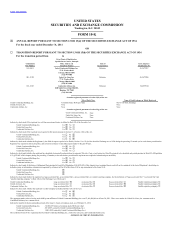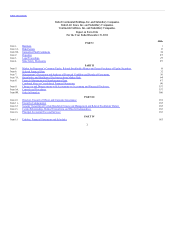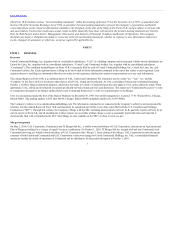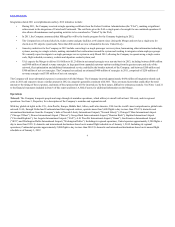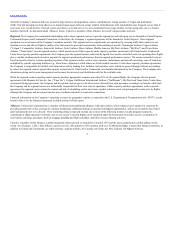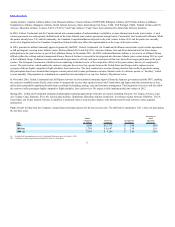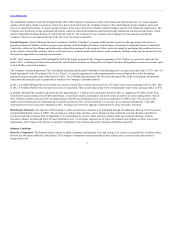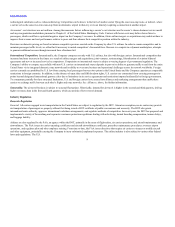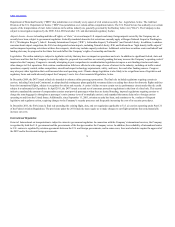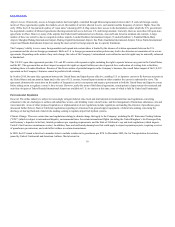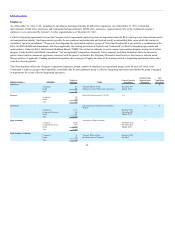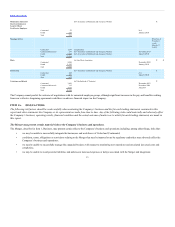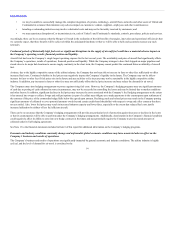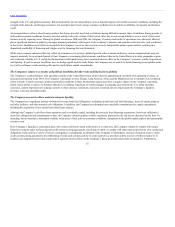United Airlines 2011 Annual Report Download - page 6
Download and view the complete annual report
Please find page 6 of the 2011 United Airlines annual report below. You can navigate through the pages in the report by either clicking on the pages listed below, or by using the keyword search tool below to find specific information within the annual report.
Table of Contents
All of the Company’s domestic hubs are located in large business and population centers, contributing to a large amount of “origin and destination”
traffic. Our hub and spoke system allows us to transport passengers between a large number of destinations with substantially more frequent service than if
each route were served directly. Our hub system also allows us to add service to a new destination from a large number of cities using only one or a limited
number of aircraft. As discussed under below, United is a member of Star Alliance, the world’s largest airline network.
Regional. The Company has contractual relationships with various regional carriers to provide regional jet and turboprop service branded as United Express,
Continental Express and Continental Connection. In the future, the Company’s regional operations will be branded as United Express. These regional
operations are an extension of the Company’s mainline network. This regional service complements our operations by carrying traffic that connects to our
mainline service and allows flights to smaller cities that cannot be provided economically with mainline jet aircraft. Chautauqua Airlines, Colgan Airlines
(“Colgan”), CommutAir Airlines, ExpressJet Airlines, GoJet Airlines, Mesa Airlines, Shuttle America, SkyWest Airlines (“SkyWest”) and Trans States
Airlines (“Trans States”) are all regional carriers, which operate most of their capacity under capacity purchase agreements with United and/or Continental.
Under these capacity purchase agreements, the Company pays the regional carriers contractually-agreed fees (carrier-controlled costs) for operating these flights
plus a variable reimbursement (incentive payment for superior operational performance) based on agreed performance metrics. The carrier-controlled costs are
based on specific rates for various operating expenses of the regional carriers, such as crew expenses, maintenance and aircraft ownership, some of which are
multiplied by specific operating statistics (e.g., block hours, departures) while others are fixed monthly amounts. Under these capacity purchase agreements,
the Company is responsible for all fuel costs incurred as well as landing fees, facilities rent and other costs, which are passed through without any markup.
In return, the regional carriers operate this capacity exclusively for United and/or Continental, on schedules determined by the Company. The Company also
determines pricing and revenue management and assumes the inventory and distribution risk for the available seats.
While the regional carriers operating under capacity purchase agreements comprise more than 95% of all regional flights, the Company also has prorate
agreements with Hyannis Air Service, Inc. (“Cape Air”), Colgan, Gulfstream International Airlines (“Gulfstream”), SkyWest and Trans States. Under these
commercial flying agreements, the Company and its regional carriers agree to divide revenue collected from each passenger according to a formula, while both
the Company and its regional carriers are individually responsible for their own costs of operations. Unlike capacity purchase agreements, under a prorate
agreement, the regional carrier retains the control and risk of scheduling, and in most cases, market selection, local seat pricing and inventory for its flights,
although the Company and its regional carriers may coordinate schedules to maximize connections.
Financial information on the Company’s operating revenues by geographic regions, as reported to the U.S. Department of Transportation (the “DOT”), can be
found in Note 10 to the financial statements included in Item 8 of this report.
Alliances. United and Continental have a number of bilateral and multilateral alliances with other airlines, which enhance travel options for customers by
providing greater time of day coverage to common destinations, additional mileage accrual and redemption opportunities, and access to markets that United
and Continental do not serve directly. These marketing alliances typically include one or more of the following features: loyalty program reciprocity;
codesharing of flight operations (whereby seats on one carrier’s selected flights can be marketed under the brand name of another carrier); coordination of
reservations, ticketing, passenger check-in, baggage handling and flight schedules, and other resource-sharing activities.
United is a member of Star Alliance, a global integrated airline network co-founded by United in 1997 and the most comprehensive airline alliance in the
world. As of January 1, 2012, Star Alliance carriers served 1,290 airports in 189 countries with over 21,000 daily flights. Current Star Alliance members, in
addition to United and Continental, are Adria Airways, Aegean Airlines, Air Canada, Air China, Air New Zealand, All Nippon Airways,
5

